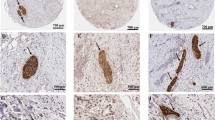Summary
Specimens from four patients who underwent resection of cancer of the pancreatic head were examined histologically by serial sections to study the patterns of extrapancreatic nerve plexus invasion of cancer. To understand the mode of neural invasion and its specificity for pancreatic cancer, we also examined retropancreatically transplanted virus-induced rabbit papilloma (VX2) cells in six rabbits. Histological evaluation of the specimens from patients revealed neural invasion near the primary lesion, where cancer cells broke the perineurium and showed communication of cancer cells between the inside and outside of the perineurium. Tumor cells found distant from the primary cancer were confined to the perineurium, grew in a continuous pattern, and followed the branches of nerves. When the rabbit’s VX2 cells were implanted into the retropancreatic region of recipient rabbits we also observed neural invasion. This study shows that neural invasion is a common, but not a specific, feature of pancreatic cancer, and it suggests thaten bloc excision of the retropancreatic tissue, including fat tissue and the extrapancreatic nerve plexus, should be the basic procedure of radical surgery in the treatment of pancreatic cancer.
Similar content being viewed by others
References
Nagakawa T, Kurachi M, Konishi K, and Miyazaki I. Retroperitoneal dissection for pancreatic cancer—Translateral retroperitoneal approach. I no Ayumi 1979; 111: 339–341 (in Japanese).
Nagakawa T, Kurachi M, Konishi K, and Miyazaki I. Translateral retroperitoneal approach in radical surgery for pancreatic carcinoma. Jpn. J. Surg. 1982; 12: 229–233.
Nagakawa T. Significance of the extended radical operation for pancreatic cancer—surgical results and postoperative problems. New Trends in Gastroenterology, JSGE, Tokyo, 1987; 205–214.
Nagakawa T, Konishi I, Higashino Y, Ueno K, Ohta T, Kayahara M, Ueda N, Maeda K, and Miyazaki I. The spread of prognosis of carcinoma in the region of the pancreatic cancer. Jpn. J. Surg. 1989; 19: 510–518.
Japan Pancreas Society. The general rules of clinical and pathological management of carcinoma of the pancreas. Tokyo, Kanehara, 1986 (abstract in English).
Rous P and Beard JW. The progression to carcinoma of virus-induced rabbit papilloma. J. Exp. Med. 1935; 62: 523–548.
Fortner JG. Regional resection of cancer of the pancreas: a new surgical approach. Surgery 1973; 73: 307–320.
Nakao S, Ichihara T, and Nonami T. Clinicopathological and immunoclinical evaluation about the intrapancreatic extension of carcinoma of the head of the pancreas. Jpn. J. Surg. 1987; 88: 735–742 (abstract in English).
Ishikawa O, Daito H, and Imaoka Y. Clinicopathological evaluation about the range of resection of the pancreas in carcinoma of the head of the pancreas. Jpn. J. Surg. 1984; 85: 363–369 (abstract in English).
Herter FP, Cooperman AM, and Ahlbohn TV. Surgical experience with pancreatic and periampullary cancer. Ann. Surg. 1982; 195: 274–281.
Nagai H. Studies on metastases of the paraaortic lymph nodes and its passway in pancreatic cancer. Jpn. J. Surg. 1987; 88: 308–317 (abstract in English).
Matsuda M and Nimura Y. Perineural infiltration in carcinoma of the head of the pancreas. Jpn. J. Surg. 1983; 84: 719–728 (abstract in English).
Nagayo T, Murakami N, and Matsuoka Y. Local neural invasion in carcinoma of the gallbladder and bile duct. Clin. Cancer 1976; 22: 1406–1409 (abstract in English).
Okamoto M, Nakamura Y, and Imaizumi M. Construction of peripheral nerve. Saishin Igaku 1968; 23: 2240–2252 (in Japanese).
Rodin AE, Larson DL, and Roberts DK. Nature of the perineural space invaded by the prostatic carcinoma. Cancer 1967; 20: 1772–1779.
Nakase A, Koizumi T, and Fujita N. Study of the growth and infiltration of experimental tumor of the pancreas in rabbits. Am. J. Surg. 1977; 133: 590–592.
Bock P and Hanak H. Die Verteilung exogener Peroxydase im Endoneurium. Histochemie 1971; 25: 361–371.
Shanthaveerappa TR and Bourne GH. The perineural epithelium. A metabolially active, continuous, protoplasmic cell barrier surrounding perpheral cerve fasciculi. J. Anat. Lond. 1962; 96: 527–537.
Baliantyne AJ, WcCarten AB and Ibanez WL. The extension of cancer of the head and neck through peripheral nerves. Am. J. Surg. 1963; 106: 751–767.
Author information
Authors and Affiliations
Rights and permissions
About this article
Cite this article
Nagakawa, T., Kayahara, M., Ohta, T. et al. Patterns of neural and plexus invasion of human pancreatic cancer and experimental cancer. Int J Pancreatol 10, 113–119 (1991). https://doi.org/10.1007/BF02924114
Received:
Revised:
Accepted:
Issue Date:
DOI: https://doi.org/10.1007/BF02924114




